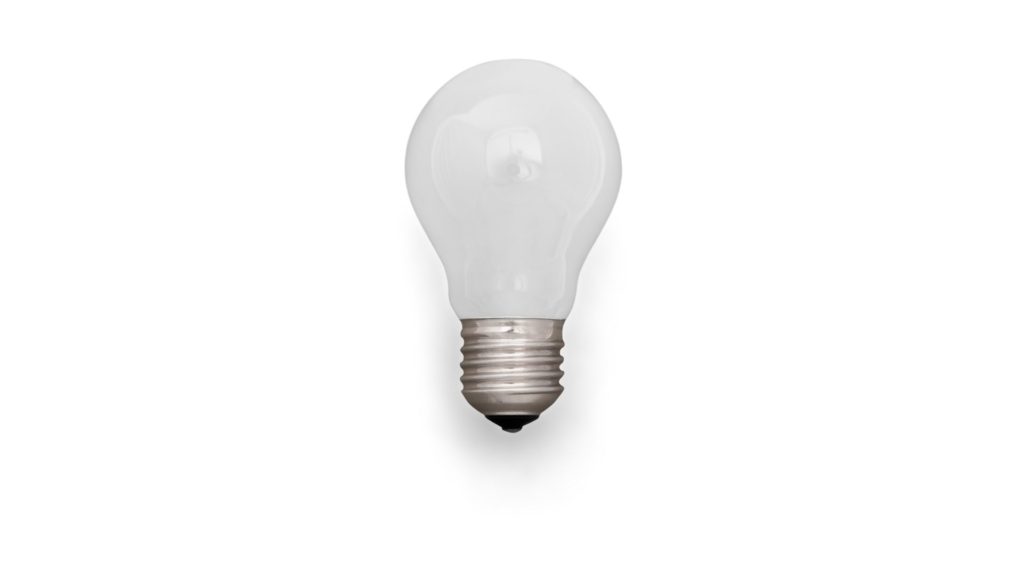The figure is much higher than you realize, especially if you have dozens of bulbs in your home. The type of bulb is very important. Some lighting types are less efficient than others because they waste a lot of energy as heat. This is why homeowners with incandescent bulbs are plagued by higher electric bills than individuals with LED lighting.
How Much Does It Cost To Run A 60 Watt Bulb?
The cost to run a 60-watt incandescent bulb is 0.72 cents per hour, 17.28 cents per 24 hours, 525.6 cents per month and 6307.2 cents per year assuming electricity costs 0.12 cents per Kilowatt-hour
Cost To Run 60 Watt Bulb
| INCANDESCENT (60W) | LED (10W) | |
| PER HOUR | 0.72 | 0.12 |
| 24 HOURS PER DAY | 17.28 | 2.88 |
| PER MONTH | 525.6 | 87.6 |
| PER YEAR | 6307.2 | 1051.2 |
You can’t take these figures at face value. First of all, the numbers in this table apply to situations where each kilowatt-hour of electricity costs 12 cents. Additionally, the cost per hour/day/month/year is presented in cents.
For instance, you will spend 6307.2 cents a year on a 60W incandescent bulb, which amounts to $63. It doesn’t cost $6307.2 to run a 60W incandescent bulb.
If you calculate the cost of running an incandescent bulb in cents, you can use tools like convert units to change the cents to dollars. You can also convert the cents into dollars before calculating the cost of running the bulb.
One dollar equals 100 cents. Therefore, you can convert 12 cents to $0.12 before proceeding with your calculations.
Related post:
- Can I Use A 60 Watt Bulb In A 40 Watt Lamp?
- Can I Use 220v Light Bulb In 110v?
- How Much Does It Cost To Run A 250 Watt Heat Lamp? (Per Day)
- Cost To Run 100 Watt Bulb
How To Calculate The Cost To Run 60-Watt Bulb?
Experts use watts to measure the energy a bulb consumes. Regency lighting equates the unit to one joule per second. People associate the wattage with brightness, and for a good reason.
The wattage does not measure the brightness of a bulb. However, it can give you an idea of the brightness you can expect. For instance, you don’t need anyone to tell you that a 100W bulb is brighter than a 60W bulb.
A kilowatt is similar to a watt. It shows you the volume of energy the bulb will consume. One kilowatt equates to a thousand watts.
You need to understand what terms like ‘Watt’ and ‘Kilowatt’ mean to make sense of ‘Kilowatt-Hour.’ ‘Kilowatt-hour’ is not the same as ‘Kilowatt.’ ‘Kilowatt’ measures the amount of energy a bulb consumes.
However, ‘Kilowatt-hour’ measures the amount of energy a bulb will consume within a specific period.
- If you have a 60W bulb and want to calculate the cost of running it, start by turning those 60 watts into kW. This is a simple matter of dividing 60 by 1000, which gives you 0.06kW.
- At this point, you can determine the kWh if you multiply the kW by the number of hours the bulb will remain in operation. For instance, if you intend to use the bulb for 24 hours, multiply 0.06kW by 24 hours. This gives you 1.44kWh, which is the amount of electricity the bulb will consume in 24 hours.
- Multiplying 1.44kWh by the cost of each kWh in your area will tell you the cost of running the bulb for 24 hours. For example, if each kWh costs 12 cents in your area, multiply 1.44kWh by 12 cents. The answer is 17.28 cents. In other words, running a 60W bulb for 24 hours will cost you 17.28 cents.
Once you know the kWh, you can change the hours in the formula to determine the cost of running a bulb within a specific period. For instance, rather than 24 hours, you can use ‘730 hours,’ the average number of hours in a month, or ‘8760 hours,’ which is the average number of hours in a year.
Sciencing has another example that explains this formula. They have also provided a calculator that automatically turns watts into kilowatts. Endeavor to change the wattage of your bulb into kWh. Your energy supplier will most likely measure your consumption in kilowatt-hours.
The Factors That Matters While Calculating The Cost
- Watts – The manufacturer will print the wattage of the bulb on the packaging or the bulb itself.
- kW – You can calculate the kilowatts if you divide the wattage by 1000 (60W/1000 = 0.06kW)
- kWh – You can calculate the kilowatt-hours if you multiply the kW by the number of hours the bulb will remain in operation (0.06kW x 24 Hours = 1.44kWh
- Cost of kWh – Ask your energy supplier to tell you the cost of each kilowatt-hour.
- Cost of Running The Bulb – Multiply the kWh by the cost of each kWh (1.44kWh x 12 cents (the price of each kWh in some places) = 17.23 cents)
Does The Incandescent Bulb VS LED Make A Difference In Running Cost?

LEDs and incandescent bulbs are very different from one another. LEDs are more energy-efficient and cost-effective than incandescent bulbs. Some people don’t believe these claims. They think that LED manufacturers are simply trying to increase their sales. But the numbers speak for themselves. Consider the following:
1). A 10W Led Brightness Is Equivalent To 60W Incandescent
You have to start by considering the brightness because it is the first variable people consider. Many people think that a 60W LED light is just as bright as a 60W incandescent bulb. But that couldn’t be further from the truth.
60W incandescent bulb has the same brightness as a 10W LED light.
However, manufacturers will not advertise a 10W LED light with the ‘10W’ label.
They may give it a ‘60W’ rating. This doesn’t prove that the 10W LED light uses 60 watts. The manufacturers want people to know that the 10W LED delivers the same brightness as the 60W incandescent bulb.
If they used technical language, they would tell you that 60W incandescent bulbs produce 800 lumens. ‘Lumens’ is a unit of measurement that reveals the brightness of a light.
An incandescent bulb requires 60 watts to produce 800 lumens of brightness. However, based on the information volt lighting has provided, you can see that LEDs need just 12 watts to deliver 800 lumens of brightness.
Your 60W LED bulb doesn’t use 60 watts. If you had an LED light with an actual rating of 60 watts, you would hate it. The bulb would overwhelm you with its brightness.
2). Led Light Has Higher Lifespan
A 60W incandescent bulb has a lifespan of 1,000 hours. On the other hand, a 60W LED light can survive 25,000 hours. Remember, even though the LED light has a ‘60W’ label, it only uses 12 watts or even less.
3). Led Light Is Expensive But More Durable
You can buy an incandescent bulb for $2.70. On the other hand, an LED light will cost you $6.25. This assumes that you bought a 60W incandescent bulb and a 12W LED lamp. The incandescent bulb is obviously cheaper.
But you can’t forget the lifespan. You have to replace the incandescent bulb after a thousand hours, whereas LED lights can last 25,000 hours. Even though the incandescent bulb is cheaper, you may replace it two dozen times before the LED option stops working.
Would you rather buy 24 incandescent bulbs or one LED light in three years? The LED bulb is less expensive in the long run.
4). Led Light Is More Efficient
You don’t need a mathematician to tell you that 60W incandescent bulbs use more energy than their LED counterparts. An LED bulb uses 12 watts to produce the same brightness as a 60W incandescent light.
Because incandescent bulbs use more energy, they will cost more money. Incandescent lighting wastes a lot of energy as heat. This is why you have to wait a few minutes after switching an incandescent bulb off before you change it.
If you touch an incandescent bulb with your bare hands, it can easily burn you, especially if it has been in use for hours. LEDs produce little or no heat. This speaks to their efficiency.
Is There Any Way To Decrease The Running Cost?
Use LED Bulb
You cannot make incandescent lights more efficient. Your only option is to use LED lighting.
According to sustainability Victoria,
LED is 60 percent more efficient than incandescent. Depending on the brand, LEDs can easily work for 50,000 hours.
If you have children and the lights are within their reach, LEDs are safer because they generate less heat.
Switch The Lights Off
This is the most obvious solution on the table. Switch the lights off whenever you leave the room. You can also switch them off if the ambient lighting is sufficient. You don’t have to use the bulbs in your room when your desk is situated next to an open window on a sunny day.
Use Sensors
Use sensors that activate and deactivate the lights when people enter or leave a room. Many people unconsciously waste energy because they forget to switch the lights off. This isn’t an issue if you have sensors.
You can apply this technology to security lights. Sensors can switch the lights on or off depending on whether the sun is rising or setting.
The technology is more expensive than a conventional light. But it will save you a lot of money in the long run.
Keep The Lights off At Day
Limit your business activities to the daytime, where you can rely on natural daylight. Keep the lights off until the sun goes down.
Use Dimmers
You don’t have to use your lights at full brightness. Try dimming them whenever full brightness becomes unnecessary.

